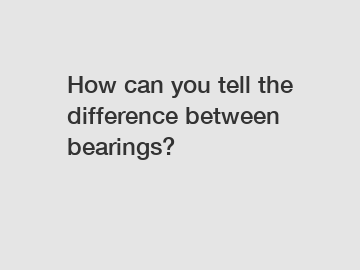How can you tell the difference between bearings?
How can you tell the difference between bearings?
Bearings are mechanical components widely used in various industries to reduce friction between moving parts and provide support for rotational or linear motion. However, there are different types of bearings available, and it is essential to understand how to differentiate between them to ensure proper selection and performance. In this article, we will explore the various factors that can help you distinguish between different types of bearings.
Classification based on construction:

One way to distinguish bearings is by considering their construction. There are mainly two types: ball bearings and roller bearings. Ball bearings, as the name suggests, use balls to separate the moving parts, while roller bearings utilize cylindrical, spherical, or tapered rollers for the same purpose. By analyzing the design and structure of a bearing, one can easily identify whether it falls into the ball or roller category.
Classification based on load capacity:
Another aspect to look at when differentiating bearings is their load capacity. Bearings are designed to withstand different levels of radial and axial loads, and this factor heavily influences the construction and materials used. For example, deep groove ball bearings are suitable for high-speed operations but have limited load-carrying capacity compared to spherical roller bearings, which can handle heavy loads. By understanding the intended application and the load requirements, one can determine the appropriate type of bearing.
Classification based on application:
Different types of bearings are designed to cater to specific applications. For instance, angular contact ball bearings are commonly used in machine tool spindles, where they can handle both radial and axial loads. On the other hand, thrust bearings are ideal for applications that require axial load support, such as automotive transmissions. By examining the intended use and the operating conditions, one can identify the most suitable bearing type.
Classification based on lubrication:
Lubrication is crucial for the optimal performance and longevity of bearings. Some bearings are designed to operate with grease lubrication, while others require oil or even dry conditions. By understanding the lubrication requirements of a bearing, one can determine whether it is suitable for a particular application. For example, sealed bearings are commonly used in environments where contamination is a concern, as they provide excellent protection against debris and moisture.
In conclusion, the difference between bearings can be distinguished based on their construction, load capacity, application, and lubrication requirements. Understanding these factors allows engineers, technicians, and users to select the most appropriate bearing type for a given application. Proper bearing selection ensures optimal performance, reliability, and longevity, ultimately contributing to efficient and cost-effective operations across various industries. So whether you are involved in manufacturing, automotive, or any other field that utilizes bearings, knowing how to differentiate them is of utmost importance. Start by familiarizing yourself with the key factors discussed in this article, and make informed decisions when it comes to bearing selection.
For more information, please visit china automotive clutch separation bearing and unit, cross joint function, clutch release bearing function.
183
0
0

Comments
All Comments (0)